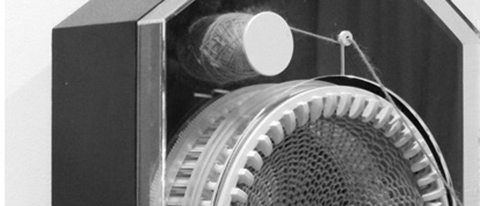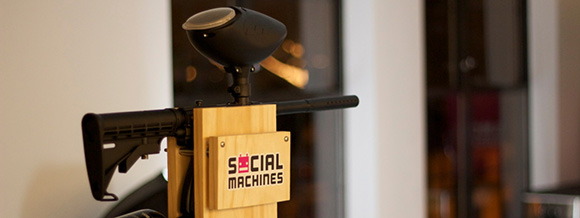Cheap GPS modules

If you’re making a GPS-enabled project, you may have noticed the commonly available GPS modules are pretty expensive – usually around $50. Here’s one for $8. It’s a U-blox PCI-5S GPS receiver on a PCI Express card. There are test points for serial and USB data, though, so fitting this in your project is a breeze.
Grandfather clock makes a giraffe’s scarf

Here’s a clock project from [Siren Elise Wilhelmsen]. Over the course of 365 days, the clock knits a giant, 2-meter tube of yarn that should be the perfect start for a half-dozen pairs of socks. No video for this, but if you find one, post a comment.
A huge hackerspace for Hotlanta

Atlanta is getting a new hackerspace. It’s called My Inventor Club and they’re starting to move into their space. Judging from [Scott]’s pictures of the new space it’s huge. We can’t wait for the video tour once they’re done moving in.
Ardino and Windows 8

Windows 8 is… weird… and you can’t install unsigned drivers without a lot of rigamarole. This means installing the Arduino IDE is a pain but [Dany] has a solution. Reboot into “test mode” and you can install unsigned drivers without your computer throwing a hissy fit.
Tweet for welts and bruises

[Zach]’s boss told him to come up with a Twitter-controlled paintball gun. Why he was asked to build this is beyond us, but the build is still cool. It’s powered by an Arduino and was built in just 12 hours. If only there was a video stream…
Hey guys, need some help here.
Alright, I’ve got a little problem with component sourcing. I’m making a ‘shield’ for the Raspberry Pi. Does anyone know where I can get really long female headers for the GPIO pins so the board will fit over the USB and Ethernet jacks? Here’s the project if you’re curious. I think the female part of the header needs to be 14mm high at least to fit over the USB port.
EDIT: Samtec ESQ-113-33-L-D. Here’s their site. This site is amazing. You can actually… find things. Completely unique experience here. Thank you, [Richard].















Love the cheap-GPS alert. Looks good.
For the female headers…can’t you repurpose some long-pin female Arduino headers? Get Caleb to print you some spacers if that’s not long enough, or cut up some more headers and slip them over the pins.
Actually the gps is more close to $17 ($12 and 5$ for the antenna). Still interesting.
But how does it compare to a sirfstar III receiver ?
uBlox Max-6Q: $12, add $1.50 for a large active patch antenna from China
How about a link there Mike. I cant seem to find this price you are mentioning.
Stack 2 long pin headers on top of one another, total female socket height about 18mm. Long pin headers in single and double row forms are easily found on ebay, admittedly it’s not entirely “professional”, but it would get the job done.
If anyone does the headers you want, it will be Samtec. They do all manner of different head and tail lengths for each model with all the options very clearly laid out on their nice orange and brown datasheets. Samtec have always sent me the free samples I’ve asked for too – usually 5-10 of each requested header. Their Elevated Socket ESW and ESQ models look like just what you want.
Oh wow. That’s the most pleasurable experience I’ve ever had searching for pin headers.
Seriously. That… was amazing.
I agree. Even their site loads incredibly fast, from only four servers including google. From never hearing them before to finding a 3d rendered, fully dimensioned piece that could suit your needs including documentation and white papers in under 50 seconds.
Samtec Rocks be careful the insertion force on the headers is specable I would suggest if you want to get it off again go with the lowest.
Samtec is *great* – I love them. Free samples, next day fedex. Be aware the long pins come in two flavors: square and rectangular (ESQ=square; ESW=rectangular, if I remember). Get samples of both. They don’t co-mingle well, and the rPi probably likes the square. The “generic” long-pins are designed for/as PC104 connectors. Also – get a copy of their paper catalog. Nerd porn at its finest, right by Digikey and Mouser catalogs.
Still working on my clock project, the GPS will come in handy. I’ve ordered one.
There are several places that do raspberry pi stacking headers, they look like they would do what you want. e.g. https://www.adafruit.com/products/1112 and http://www.hobbytronics.co.uk/raspberry-pi/rpi-stackable_header-long
Possible option for raspberry pi headers, the stack through female headers used in PC104 type connectors. Toby electronics sell them. http://www.toby.co.uk/content/catalogue/products.aspx?series=309AE-xx-xG-xx-1555
I think the ones you want are 309AE-26-SG-3Z-1555 I’ve not tried it, but it looks like your needing a 26pin (2x13pin) and I think its tall enough. So you can test your counter. ‘not a hack’ :-)
If I were you I’d hack up one of those ribbon cables that adafruit sells for those RPI pins. Just shorten as needed for your use case. Obr double/triple stack some f-to-male headers as needed.
That unsigned drivers hack is not necessary anymore. The Arduino team has signed their drivers now after years of ignorance.
http://code.google.com/p/arduino/issues/detail?id=1040
And these drivers are included in the latest beta Arduino download from the site.
I love the knitting clock. Not so much for any particular reason other than that I’ve always been fascinated by the idea of automated knitting.
Yes, a bit weird.
Also really curious about how to automate knitting chainmail.
Anyway, I wish there was a better writeup on that clock so i could understand how it does the knitting. I feel like I want to make a few hundred feet of tubular scarves.
Interview with the clock’s designer:
https://www.youtube.com/watch?v=vpl-Pj6sWmI
Includes a few shots, but there is not much action to see on a 24-hour clock.
Thanks, that was pretty cool. I understand there’s not much “action” to be seen, but it’s not the clock part I’m curious about, it’s how the knitting is done mechanically. I guess I’ll have to go dig around and see if there is anything about mechanical knitting out there.
How it’s made.
Ok so with the clock it looks like a circular knitting machine that is motorised and slowed down to 24hr (theoretically not too hard).There are lots of videos on knitting machines (circular and horizontal) but I’m struggling to find detailed drawings (i can get my head around) or plans on making one in a really large or small scale. Maybe if someone can destroy their little sister old toy and post a teardown video we might be able to build these ourselves! (I want one ASAP, it’s nearly winter in Canberra Aus.)
The GPS boards work well – got mine for £3 and the same again for an active patch antenna. One downside is they dont have the flash memory that some uBlox chipsets have so cannot be upgraded to the latest firmware or have some of the settings saved – that doesn’t stop you sending a config to them after power on though and the defaults should be fine for most applications.
Has anyone figured out what the other test points on the board do yet? I’m thinking it may be I2C, the second serial port, the 1Hz clock signal or lock good indication.
I’d also suggest buying a Mini PCI-e connector – the ground test pad is straight onto the plane with no thermal relief (I wouldn’t expect it for a test point though) so it ideally needs a powerful iron or a preheater. Soldering to the PCI-e pins would be easier but a connector will give you USB.
Dont forget to add a high efficiency LDO – 300mA should be fine as it runs at about 120mA if you want to power from 5V. I boxed mine with a USB connector on the box for either USB or power in then kept only the serial out so it will interface to 5V without a level shifter (the input is not 5V tolerant).
BitWizard is also selling long 26-pin headers: http://www.bitwizard.nl/catalog/product_info.php?cPath=35&products_id=130
Thanks for the GPS heads-up, I just ordered one and an appropriate antenna, wondering what I can now use it for… :)
Does anyone know if you can saw the GPS in half? To me it looks like it should work, since there is also a (more expensive, 49$) half-size mini-pcie card with the same chipset that looks like this card with the connector moved closer to the chips.